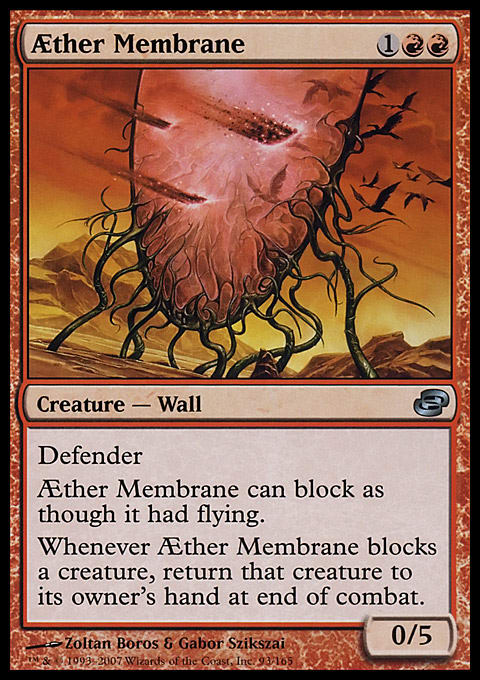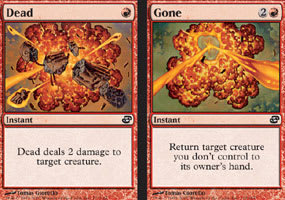I did not, as it turns out, win last week’s Pro Tour Qualifier, but that just means you get exciting Magic design content instead of a boring tournament report. Last week, we left off with a lot of vaguely formed ideas about Kegree’s mechanics that were inspired by the world I imagined around an enchantment theme. That mechanical identity quickly became submerged in a broader one based around generational struggle. Properly executed, this theme would divide the player base in much the same way that the Mirran–Phyrexian war did, but I’m not looking to make Scars of Mirrodin II: Electric Boogaloo, and my “brilliant” idea of having this guy show up to aid the metal heads wasn’t about to help matters:

On top of that, having both Auras and Equipment running around doesn’t support the factions’ conflict in gameplay because they each contribute to making a single creature into an unstoppable monster. Emphasizing both together could be cool in a setting in which players were supposed to be choosing a champion for a duel in an arena, but if Equipment doesn’t support the rebellion feel, they have no reason to be highlighted in the set at all.
Starting Fresh
Taking a step back, there’s no reason to equate the divide between Avatar followers and others to the divide between faith and skepticism. Humans on Earth were abandoning religions millennia before it was acceptable not to believe in a higher power; they simply invented new ones.
Why do we have angry gods? How about because they broke free from the prison an enterprising planeswalker trapped them in after deciding to take over the plane?

She comes bearing gifts, but dare you accept them when you know she plans to use you for her own devices?
Pie à la Mode
This new storyline begs us to redefine the faction lines. There’s less rebellion here, though following Yeawon still requires some acceptance of change—characteristic of blue’s philosophy. Black now easily aligns itself with the side that offers tangible power, and green and white maintain their status quo stance. Red is the odd man out this time, but using the same argument for having the more established group be larger, we could throw it in with the Aura-lovers. And I was all set to do that . . . until Robby Rothe brought up an #mtgdesign question on Twitter:
At first, I didn’t think much of the proposition. After all, it wasn’t the first time I’d heard red bounce proposed, and as far as I was concerned, it didn’t really add enough to win a spot alongside Panic Attack in red’s slice of the pie.
I thought nothing more of it until Alex Spalding brought up red tapping a couple of days later.

I’m not a fan of this approach. When used at sorcery speed (or on an attack trigger), tapping does virtually the same thing as making a creature unable to block for a turn. Not only is it needlessly confusing to have both effects in one color, but it detracts from red’s mechanical identity by introducing overlap with blue and white. Tapping is different than preventing blockers when it can be used on an opponent’s turn, but at that point, it makes me wonder why red is trying to stop a fight from breaking out. (“Can’t block” is just letting your creatures fight your opponent.)
Green with Envy
After a bit more discussion, Wobbles brought up green tapping in the vein of Orochi Ranger, Entangling Vines, and Clinging Mists. At present, white and blue use tapping very similarly. The only real divide is that white receives pure tappers such as Blinding Mage, and blue’s tappers give an additional option to untap the creature (Puppeteer). In much the same way that red creatures attack each turn if able and black creatures can’t block, I could see blue always getting Claustrophobia and white always getting Narcolepsy. Moving the “frozen” ability out of white would allow green to get more Entangling Vines.
Why go to the effort of making a distinction? Keeping an already-tapped creature from untapping only deals with creatures through combat (most of the time), while a full Claustrophobia effect would give green universal removal. Then again, green doesn’t need a whole lot of removal in the first place, so I’d rather just stick to fight and Fog, and it seems the powers that be agree. Crypt Rat went ahead and asked Mark Rosewater about green tapping on tumblr, to which the Head Designer replied: “White and blue already have creature tapping in their parts of the color pie. The ability doesn’t need (or should be) in three colors.”
Back in the Red Zone
So, tapping doesn’t seem to be due for a change, but all of the discussion led me to reconsider my stance on red bounce. Rosewater has often highlighted how hard it is to design red commons. The reason for this difficulty is that red has very little pie that can appear at common, and you don’t want it to play the exact same way in every Limited format. In the end, most of red’s effects boil down to burn spells. Granting first strike at instant speed is basically just burning the blocked or blocking creature, while granting it as a sorcery (where it’s pseudo-evasion) is just burning the defending player. +X/+0 effects similarly either burn the creature yours is in combat with or the defending player, and granting haste to swing past tapped creatures is nothing more than a barrage of fire to the face. Panic Attacks are Lava Axes; even red’s creatures act like burn spells because of their low toughness. Yes, red gets land destruction, and now looting, but a little bit more variety would do the color good.
As for precedent, red has had creatures such as Viashino Sandscout that return themselves to your hand as a drawback since Visions, but when Wizards brought the mechanic back en force in Urza’s block, one card received a twist: Viashino Sandswimmer’s ability is an upside! Still, the mechanic filled its intended role until Oni of Wild Places allowed it to do tricks with Flametongue Kavu and company. Then, Coldsnap came around and its Stalking Yeti brought the machinegun itself.
This gameplay feels way too tricky to be red in my book. If red gets bounce, it needs to be consistent with the color’s philosophy, so let’s look to the one place where color philosophy is free to ignore mechanical restrictions: Planar Chaos.
Bouncing opposing creatures is essentially another extension of “can’t block,” particularly at sorcery speed. Gone exemplifies red’s shortsightedness in dealing with problems but allows for the more protective role that R/W hybrid cards such as Fire at Will often exhibit.
Putting It All Together
Well, that tangent lasted a little bit longer than I’d anticipated. Regardless of whether red’s bounce is instant speed, it’s a very effective answer to creature Auras, totem armor be damned. If bounce became part of red’s pie, it would lend more support to an argument to put red in opposition to the Avatars’ supporters, but at this point, I’m not convinced that red should have the effect. While it does fit reasonably well from a philosophical, color-pie perspective, Planar Chaos clearly shows that a lot of things that fit that criterion shouldn’t be in different pieces of pie.
With the factions established as U/B against R/G/W, we can look to reevaluate what they ought to be doing mechanically. There is a pretty wide range of effects to offer with the Guardian's Magemark ability that work well with enchanted creatures, but that subset necessarily overlaps with abilities that actual Auras want to grant. On top of simply being aware of potential overlaps, we can mitigate this issue by looking for bonuses that aren’t really worth a card on their own.
 |
 |
As for the totem armor Auras, there’s a delicate balance to be struck between their power level and the abundance of effective removal in the format. We want to make a build-your-own-monster archetype viable in Draft without making it unbeatable. Without playtesting, it’s impossible to say what that balance is, but I’m pretty sure we don’t want any sort of totem armor Lightning Talons.
The Grass is Always Bluer
The bigger question comes with the Avatars’ freshly redefined opposition. Experiment no longer seems to be an appropriate mechanic since now we’re trying to convey a different sort of I’ll-believe-it-when-I-see-it attitude.

The fact that Saviors of Kamigawa’s wisdom mechanic was so hard to keep track of makes me wary of printing this one, but at least the information it’s looking for is already on players’ minds. I do like that reflected glory plays well with Auras without requiring them, and I like how it will often turn off and on repeatedly during the course of a game. My biggest concern is that it incentivizes players to keep their biggest creature out of combat in order to retain their bonuses, but I’m not sure how big an issue that is without playtesting. After all, if the opponent is trading for your biggest creature, he’s probably losing his as well, so you may still come out on top.
Tension
As it is, Kegree’s mechanics all push you to play with Auras, but they pull in different directions. Reflected Glory encourages you to stack everything onto one creature, while the Avatars’ mechanic asks you to spread them around. Things can’t really stay as they are because there’s nothing here for players who aren’t onboard with the set theme, and I’m not sure that the Avatars’ mechanic would have a significant fan base. So far as I can tell, the fun of Auras and Equipment is building your own creature, so discouraging that gameplay might just prove unexciting. We’ll explore that question and the question of what to add next week, but in the meantime, what do you think of the hypothetical block? Do you have a great idea for the world that could impact the set’s design—an inkling of a mechanic? Feel free to share your thoughts in the comments.



























